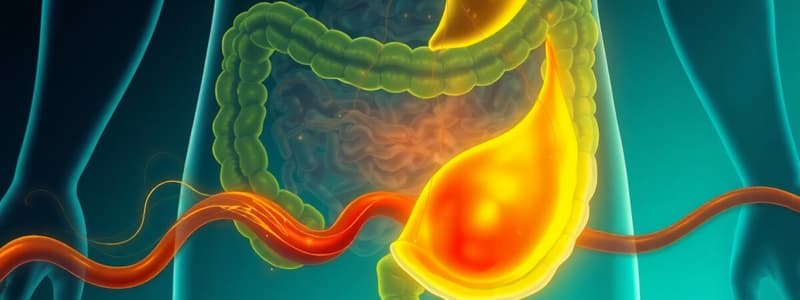Podcast
Questions and Answers
What percentage of ingested fats can be lost in the absence of bile salts?
What percentage of ingested fats can be lost in the absence of bile salts?
- 10%
- 40% (correct)
- 20%
- 30%
Which of the following is NOT a function of bile salts?
Which of the following is NOT a function of bile salts?
- Form micelles with lipids
- Aid in the absorption of lipids
- Promote cholesterol synthesis (correct)
- Emulsify fat globules
The development of gallstones is most likely associated with which dietary pattern?
The development of gallstones is most likely associated with which dietary pattern?
- Balanced diet
- High-fiber diet
- High-fat diet (correct)
- Low-fat diet
What is the primary role of bile salts in lipid digestion?
What is the primary role of bile salts in lipid digestion?
Which of the following is primarily absorbed from the gastrointestinal tract with the help of bile salts?
Which of the following is primarily absorbed from the gastrointestinal tract with the help of bile salts?
What is the consequence of inadequate bile salt secretion?
What is the consequence of inadequate bile salt secretion?
Which bodily process does NOT directly involve bile salts?
Which bodily process does NOT directly involve bile salts?
What circulatory pathway contributes to the enterohepatic circulation of bile salts?
What circulatory pathway contributes to the enterohepatic circulation of bile salts?
Which type of blood does the liver receive from the hepatic portal vein?
Which type of blood does the liver receive from the hepatic portal vein?
What condition can result from prolonged high-fat dietary intake in relation to liver function?
What condition can result from prolonged high-fat dietary intake in relation to liver function?
What is a primary function of bile in the digestive process?
What is a primary function of bile in the digestive process?
Which ion is secreted along with bile to aid in neutralizing stomach acid in the duodenum?
Which ion is secreted along with bile to aid in neutralizing stomach acid in the duodenum?
What triggers the gallbladder to empty its contents?
What triggers the gallbladder to empty its contents?
During the gallbladder's storage of bile, what process is primarily responsible for the absorption of water and electrolytes?
During the gallbladder's storage of bile, what process is primarily responsible for the absorption of water and electrolytes?
What waste product is bilirubin derived from?
What waste product is bilirubin derived from?
How much bile can the gallbladder store at maximum capacity?
How much bile can the gallbladder store at maximum capacity?
What role does secretin play in biliary secretion?
What role does secretin play in biliary secretion?
Which components primarily make up concentrated bile stored in the gallbladder?
Which components primarily make up concentrated bile stored in the gallbladder?
What type of cell secretes the watery solution of Na and HCO3 ions added to bile?
What type of cell secretes the watery solution of Na and HCO3 ions added to bile?
Which of the following is NOT a primary reason for the importance of bile?
Which of the following is NOT a primary reason for the importance of bile?
Flashcards are hidden until you start studying
Study Notes
Bile
- Secreted by the liver
- Approximately 600-1000 ml/day
- Important for fat digestion and absorption, emulsifies large fat particles into smaller ones, allowing lipase enzymes to break them down
- Aids in the absorption of digested fat products through the intestinal mucosal membrane
- Excretes waste products from the blood, including bilirubin (from hemoglobin breakdown) and excess cholesterol
Biliary Secretion
- The liver secretes bile in two stages
- Initially secreted bile is modified as it passes through the bile ducts
- Ductal epithelial cells lining the ductules and ducts secrete a watery solution of Na and HCO3 ions
- This increases bile volume by up to 100%
- Secretin stimulates additional HCO3 ion release, complementing pancreatic secretion for neutralizing stomach acid
Gallbladder
- Stores bile
- Capacity is 30-60 ml
- Can store up to 450 ml in 12 hours due to water, sodium, chloride, and electrolyte absorption
- Absorption results in concentrated bile, rich in bile salts, cholesterol, lecithin, and bilirubin
- Active Na transport drives the process, followed by secondary absorption of chloride, water, and other constituents
Gallbladder Emptying
- Stimulated by fatty foods reaching the duodenum, approximately 30 minutes after meals
- Less strongly stimulated by acetylcholine-secreting nerve fibers from the vagus nerve and the intestinal enteric nervous system, resembling the nerve function in other parts of the upper GI tract
Bile Salts
- Bile salts are critical for fat digestion and absorption
- Bile salts form micelles with lipids, aiding in the absorption of fatty acids, monoglycerides, cholesterol, and other lipids from the GI tract
- Emulsifying action of bile salts breaks down large fat globules into smaller particles
Importance of Bile Salts
- Without bile salts, up to 40% of ingested fats can be lost in feces, leading to a metabolic deficit due to nutrient loss
Enterohepatic Circulation
- Bile salts are reabsorbed in the ileum
- Circulate back to the liver via the portal vein
- Repeatedly used for fat digestion, making their production efficient
Biliary Secretion Regulation
- Amount of cholesterol in bile is influenced by dietary fat intake
- The liver synthesizes cholesterol as a product of fat metabolism
- High-fat diets can contribute to gallstone formation due to increased cholesterol levels
Studying That Suits You
Use AI to generate personalized quizzes and flashcards to suit your learning preferences.



